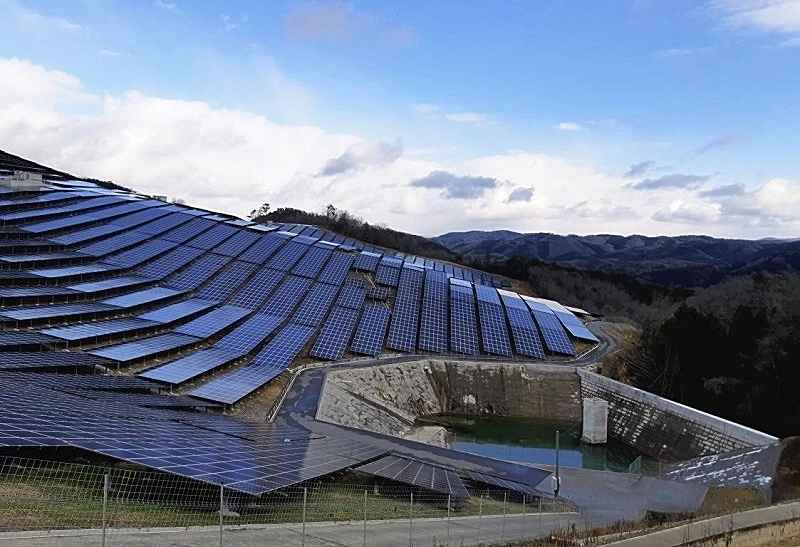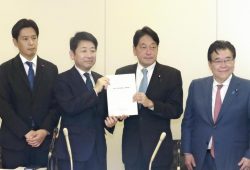
The Sakuto Mega Solar Power Plant in Mimasaka, Okayama Prefecture. A regulating reservoir can be seen in the foreground.
20:00 JST, November 5, 2022
Renewable energy companies are increasingly facing new local government taxes and restrictions on construction. The trend is driven by local residents’ concerns over possible landslides and deterioration of the local landscape caused by the rapid rise in the construction of renewable power generating facilities. With an eye on realizing a decarbonized society, the central government has begun formulating rules to prevent problems from arising between residents and business operators.
Public safety
In parts of Mimasaka, Okayama Prefecture, forests were cleared to make way for commercial solar power generating facilities, including the Sakuto Mega Solar Power Plant, one of the nation’s largest solar power facilities. However, the city is set to impose a “solar panel tax.” It will be the first time for a local government in Japan to introduce such a special tax.
With the planned tax, the city government will ask power-generating business operators to pay ¥50 per square meter of solar panels. “Areas once robed in green have been rapidly converted into land for power generation, giving rise to concerns about possible landslides, among other issues that could affect residents’ safety,” a local government representative said. The tax revenue — expected to be around ¥110 million per year — will be used to fund flood-control measures and construct evacuation facilities, the representative added.
The city government initially submitted an ordinance proposal concerning the new local tax to the city council in 2019, but it repeatedly failed to win approval or was put on hold for further consideration due to a string of objections, such as incompatibility with the central government’s policy of promoting renewable energy.
The proposal was finally approved by a majority vote in December.
Pacifico Energy — the Tokyo-based leading renewable energy company that built the Sakuto Mega Solar Power Plant — opposes the city’s move. “It’s unacceptable for our plant to be treated like a ‘nuisance facility,’ even though we took sufficient disaster prevention measures,” a company spokesperson said.
To prevent river flooding, the firm installed 21 regulating reservoirs when it developed around 410 hectares of forested mountains and former golf course land, securing a flood-control capacity that exceeds the required prefectural standard by 80%. Prior to starting construction, the company also held about 90 explanatory meetings for residents.
“If this kind of taxation becomes widespread, the spread of sound renewable energy generation will be halted,” a disgruntled company executive said.
When introducing a new non-statutory local tax for a special purpose, local governments are required to obtain consent from the Internal Affairs and Communications Minister. But in June this year, the internal affairs ministry notified the Mimasaka city government that it “should hold thorough discussions with the business operators,” effectively referring the matter back to the city authorities. Since then, the city has held dialogue with the company, but they “remain as far apart as ever,” according to a senior city government official.
Construction restrictions
Meanwhile, the Miyagi prefectural government announced in September it would tax businesses that clear forests for the purpose of installing renewable energy facilities. “We’ve worked out a way to increase the economic burden on business operators to induce them to source suitable sites other than forests,” said Miyagi Gov. Yoshihiro Murai.
Many other local governments have established ordinances that restrict the construction of such facilities. According to the Research Institute for Local Government, as of September, there were 203 municipalities with such ordinances such as those prohibiting the development of renewable energy facilities in certain areas or requiring businesses to obtain permission from the head of the municipal government prior to starting construction.
The new rules are an attempt to deal with the rapid expansion in the number of renewable energy facilities following the introduction of the feed-in tariff system in 2012, which obliges power utilities to purchase electricity derived from renewable energy sources at a guaranteed price.
According to the Economy, Trade and Industry Ministry, between April last year and February this year, 33 solar power facilities were damaged or had land partially washed away by heavy rains. Some companies are overexploiting forests without providing proper explanations — a factor that is stoking residents’ concerns.
“In addition to fears about possible natural disasters, many residents are also concerned about the negative impact of renewable energy facilities on the landscape, and tourist resources,” said a coleader of the Zenkoku Saiene Mondai Renraku-kai citizens’ group, a national liaison committee on problems related to renewable energy.
Averting trouble
From the perspective of the central government — which has set a goal of reducing the country’s greenhouse gas emissions to virtually zero by 2050 — the spread of renewable energy facilities is an absolute must. To help prevent problems from arising between residents and businesses, the central government in April 2020 made it mandatory for businesses to conduct environmental-impact assessments when planning large-scale solar power facilities.
Last month, a government expert panel compiled a set of recommendations founded on three central pillars: stricter permission and approval procedures for business operators’ development plans; mandatory prior notification to local communities, such as through explanatory meetings; and stricter on-site inspections of facilities that carry a high risk of causing a disaster.
The government plans to work on amending the current system based on the panel’s recommendations.
An executive of the Research Institute for Local Government said: “In Japan, most renewable energy facilities are built on slopes due to a lack of flat land. Under the current rules, residents’ concerns are not being properly addressed. The government must continue its efforts to strike a balance between easing local community fears and promoting the use of renewable energy.”
"Politics" POPULAR ARTICLE
-

Japan to Support Central Asian Logistics Route That Bypasses Russia, Plan to Be Part of Upcoming Summit in Tokyo
-

Japan to Tighten Screening of Foreigners’ Residential Status by Providing Information of Nonpayment of Taxes
-

Takaichi Cabinet Approval Holds at 72% as Voters Back Aggressive Fiscal Stimulus, Child Benefits
-

Chinese, Russian Bombers Flew Unusual Path by Heading Toward Tokyo; Move Likely Meant to Intimidate Japan
-

Takaichi Meets Many World Leaders at G20 Debut in Johannesburg; Speaks with Heads of Countries Including Italy, U.K., Germany, India
JN ACCESS RANKING
-

Keidanren Chairman Yoshinobu Tsutsui Visits Kashiwazaki-Kariwa Nuclear Power Plant; Inspects New Emergency Safety System
-

Imports of Rare Earths from China Facing Delays, May Be Caused by Deterioration of Japan-China Relations
-

University of Tokyo Professor Discusses Japanese Economic Security in Interview Ahead of Forum
-

Japan Pulls out of Vietnam Nuclear Project, Complicating Hanoi’s Power Plans
-

Govt Aims to Expand NISA Program Lineup, Abolish Age Restriction
























